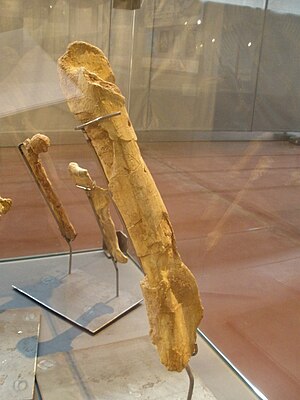Tarascosaurus
| Tarascosaurus | ||||||||||||
|---|---|---|---|---|---|---|---|---|---|---|---|---|

Thighbones of Tarascosaurus |
||||||||||||
| Temporal occurrence | ||||||||||||
| Upper Cretaceous (Lower Campanium ) | ||||||||||||
| 83.6 to 80.6 million years | ||||||||||||
| Locations | ||||||||||||
| Systematics | ||||||||||||
|
||||||||||||
| Scientific name | ||||||||||||
| Tarascosaurus | ||||||||||||
| Le Loeuff & Buffetaut , 1991 | ||||||||||||
| species | ||||||||||||
|
Tarascosaurus is a little known genus of theropod dinosaur from the Upper Cretaceous France . So far, only one very fragmentary find is known, which is composed of the upper section of the left thigh bone (femur) and two fragmentary vertebrae found in an anatomical association. Tarascosaurus is considered a representative of the Abelisauroidea , and is placed within this group by some researchers to the Abelisauridae . The only species is Tarascosaurus salluvicus .
features
The thigh bone resembles that of the possibly related Betasuchus from the Netherlands . The head of the femur is pointed slightly forward. The small roll hillock ( trochanter lesser ) is large and shows a distinctive depression (foramen). The vertebral arches of the dorsal vertebrae are similar to those of the Abelisaurid Majungasaurus and are highly pneumatized (with air-filled chambers) and short anteroposteriorly . The vertebral bodies, on the other hand, are only weakly pneumatized. Hyposphene-hypantrum connections are present.
Research history and naming
Tarascosaurus was first described in 1991 by the French paleontologists Jean Le Loeuff and Éric Buffetaut as part of a work on the then known theropod finds of the European Upper Cretaceous. The Tarascosaurus fossils have long been in the collection of the Faculté des Sciences de Lyon . The discoverer of this find is unknown. Only the origin of the fossil from the Lambeau de Beausset site , which is located in the Beausset syncline , has survived. The previously unnamed rock unit at the site was dated magnetostratigraphically to the Lower Campanium .
The name Tarascosaurus ( Tarasco - " Tarasque "; Gr. Sauros - "lizard") refers to the Tarasque, a mythical creature in the form of a dragon known in Provence . The second part of the species name, salluvicus (from Latin salluvii - " Salluvier ") refers to the tribe of the Salluvians, who settled in the area of what is now Provence in ancient times .
Systematics and validity
Le Loeuff and Buffetaut came to the conclusion that Tasascosaurus , as well as various other theropod finds of the Upper Cretaceous Europe examined by these researchers, can be assigned to the Abelisauridae . While various studies hold on to a classification of Tarascosaurus within the Abelisauridae, other studies state that such an exact assignment is not possible because of the very fragmentary nature of the finds. Ronan Allain and Xabier Suberbiola (2003), for example, note that the Tarascosaurus fossils do not show any characteristics that are only known in representatives of the Abelisauridae ( synapomorphies ). Thus tarascosaurus often than not assignable representatives of abelisaur considered.
Various researchers consider Tarascosaurus as a noun dubium and thus question the validity of this taxon , since no characteristics are recognizable that allow a clear distinction from other genera.
supporting documents
literature
- Ronan Allain, Xabier Pereda Suberbiola: Dinosaurs of France. In: Comptes Rendus Palevol. Vol. 2, No. 1, 2003, ISSN 1631-0683 , pp. 27-44, doi : 10.1016 / S1631-0683 (03) 00002-2 .
- Matthew T. Carrano, Scott D. Sampson: The Phylogeny of Ceratosauria (Dinosauria: Theropoda). In: Journal of Systematic Palaeontology. Vol. 6, No. 2, 2008, ISSN 1477-2019 , pp. 183-236, doi : 10.1017 / S1477201907002246 .
- Jean Le Loeuff, Eric Buffetaut : Tarascosaurus salluvicus nov. gen., nov. sp., dinosaure théropode du Crétacé supérieur du Sud de la France. In: Geobios. Vol. 24, No. 5, 1991, ISSN 0016-6995 , pp. 585-594, doi : 10.1016 / 0016-6995 (91) 80022-R .
Individual evidence
- ↑ a b c Carrano and Sampson , p. 209
- ↑ a b c d Le Loeuff and Buffetaut 1991 , pp. 587-588
- ↑ a b Allain and Suberbiola 2003 , p. 37